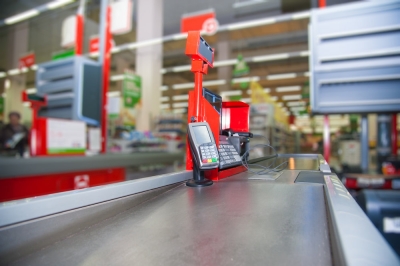
Every successful shopkeeper needs to know which goods are selling well and which are going slowly, so that he can restock or phase them out, as appropriate. For the small shop, tidy bookkeeping and a glance at the shelves may give all the information necessary. But supermarkets and other big stores need quick and accurate records of a much larger flow of merchandise. That is why they use bar codes, which are printed on the packaging.
A bar code can be read by a laser scanner, which passes it to a computer. This supplies the details and price of the goods, records the sale for storekeeping, totals the bill, and feeds the information to the cash register which prints out a receipt.
Common bar codes are European Article Numbers (EAN), based on a number with 13 digits, and Universal Product Code (UPC), based on a number with 12 digits. The Australian Product Number (APN) is also based on 13 digits. Each digit is represented by a series of parallel straight lines and white spaces. The laser scanner translates the information into binary digit signals, which it feeds to the computer.
The code gives the manufacturer details of the product and the package size, and includes a security code that prevents anyone altering it or the scanner misreading it. The computer supplies the price from the product information. So the only way to change the price of an item is by altering it in the computer.
A laser scans a bar code with a beam of light passed from one end to the other. It is sensitive enough to read from left to right or right to left. Although the bar codes are usually printed in black on a white background, a laser can read a bar code which is printed in any dark colour except red, and the background can be any pale or pastel colour. Some of the lasers used scan with red light, so cannot pick up a reflection from red.
Bar coding is faster and more accurate than other systems. Human error is limited because staff do not have to mark a price on every item, and checkout assistants do not have to key in prices at the register. However, because the computer sup-plies the prices at the checkout, the store management has to ensure that the goods on the shelves display the same prices. Also that the shelf price is changed if a computer price is altered, or a customer may appear to he charged the wrong price.
Picture Credit : Google

